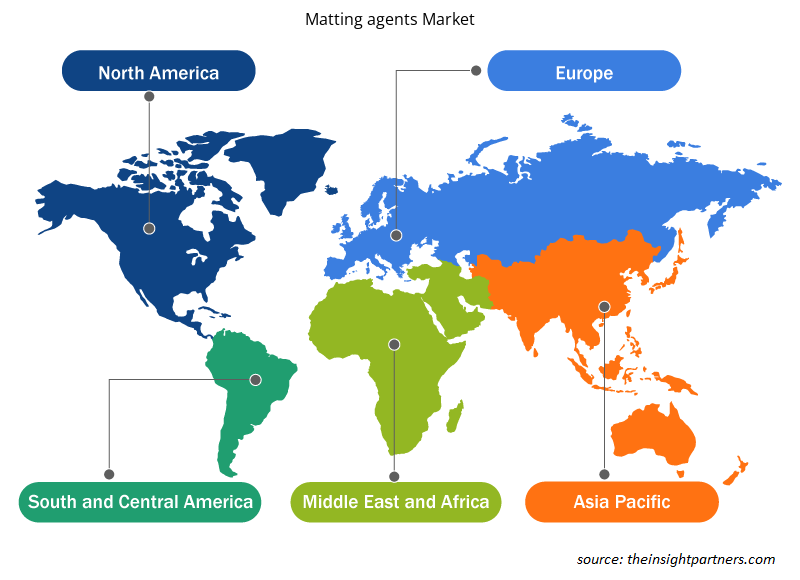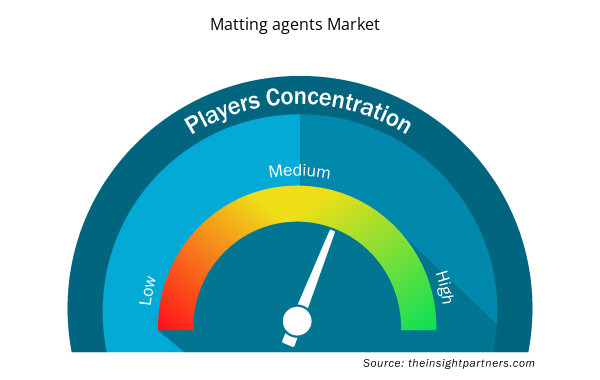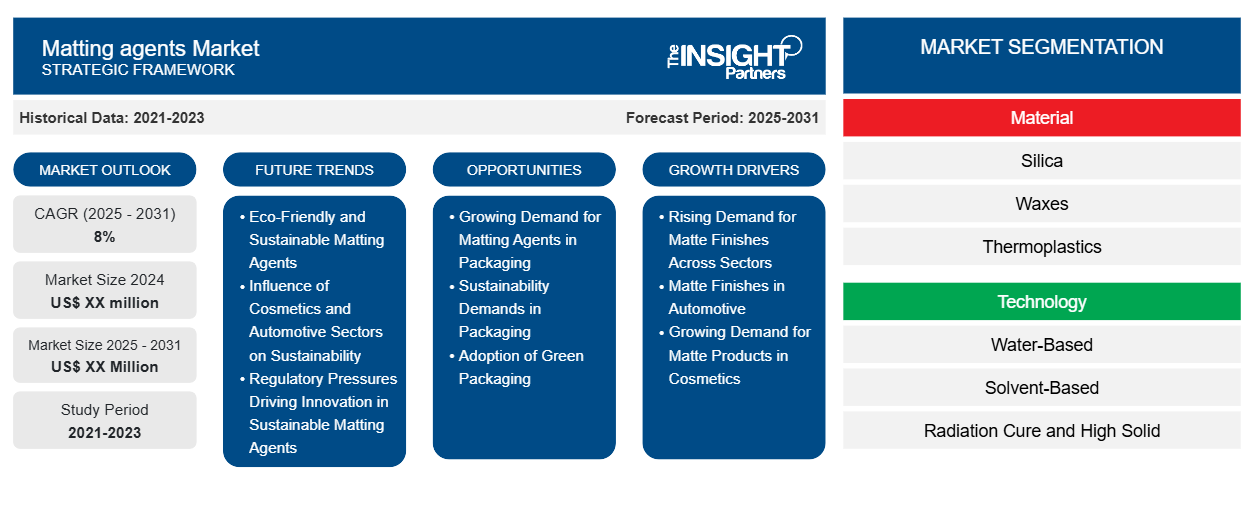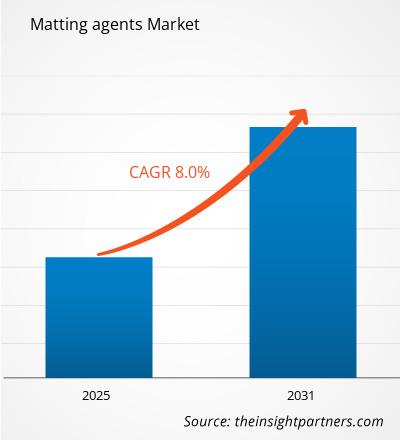Le marché des agents de matage devrait enregistrer un TCAC de 8 % de 2024 à 2031, avec une taille de marché passant de XX millions USD en 2024 à XX millions USD d'ici 2031.CAGR of 8% from 2024 to 2031, with a market size expanding from US$ XX million in 2024 to US$ XX Million by 2031.
Le rapport est segmenté par matériau (silice, cires, thermoplastiques et autres). Le rapport est également segmenté en fonction de la technologie (à base d'eau, à base de solvant, durcissement par rayonnement et à haute teneur en solides, et autres) et de l'application (industrielle, architecturale, cuir, bois, encres d'impression et autres). Le rapport couvre 5 régions : Amérique du Nord, Europe, Asie-Pacifique, Moyen-Orient et Afrique, Amérique du Sud et centrale et les principaux pays de chaque région. L'analyse globale est ensuite ventilée au niveau régional et par principaux pays. Le rapport offre la valeur en USD pour l'analyse et les segments ci-dessus.
Objectif du rapport
Le rapport sur le marché des agents de matage de The Insight Partners vise à décrire le paysage actuel et la croissance future, les principaux facteurs moteurs, les défis et les opportunités. Cela fournira des informations à diverses parties prenantes commerciales, telles que :
- Fournisseurs/fabricants de technologie : pour comprendre l’évolution de la dynamique du marché et connaître les opportunités de croissance potentielles, leur permettant de prendre des décisions stratégiques éclairées.
- Investisseurs : Effectuer une analyse complète des tendances concernant le taux de croissance du marché, les projections financières du marché et les opportunités qui existent tout au long de la chaîne de valeur.
- Organismes de réglementation : Réglementer les politiques et surveiller les activités du marché dans le but de minimiser les abus, de préserver la confiance des investisseurs et de maintenir l’intégrité et la stabilité du marché.
Segmentation du marché des agents matants
Matériel
- Silice
- Cires
- Thermoplastiques
Technologie
- À base d'eau
- À base de solvant
- Durcissement par rayonnement et à haute teneur en solides
Application
- Industriel
- Architectural
- Cuir
- Bois
- Encres d'impression
Géographie
- Amérique du Nord
- Europe
- Asie-Pacifique
- Amérique du Sud et Amérique centrale
- Moyen-Orient et Afrique
Personnalisez ce rapport en fonction de vos besoins
Vous bénéficierez d'une personnalisation gratuite de n'importe quel rapport, y compris de certaines parties de ce rapport, d'une analyse au niveau des pays, d'un pack de données Excel, ainsi que de superbes offres et réductions pour les start-ups et les universités.
- Obtenez les principales tendances clés du marché de ce rapport.Cet échantillon GRATUIT comprendra une analyse de données, allant des tendances du marché aux estimations et prévisions.
Facteurs de croissance du marché des agents matifiants
- Demande croissante de finitions mates dans tous les secteurs : Le principal moteur du marché des agents matants est la demande croissante de finitions mates dans divers secteurs tels que l'automobile, les cosmétiques et l'électronique grand public. Les gens préfèrent ces derniers temps les finitions plus mates en raison de leur attrait esthétique et de la réduction de l'éblouissement qui donne aux produits une apparence sophistiquée et moderne. C'est pourquoi les fabricants incluent des agents matants dans leurs formulations.
- Finitions mates dans l'automobile : amélioration de l'attrait esthétique : les finitions mates deviennent populaires pour l'extérieur des voitures dans le secteur automobile. Elles ont un aspect unique et haut de gamme qui différencie le véhicule sur un marché concurrentiel. Les constructeurs automobiles répondent à cette demande de personnalisation et d'expérience haut de gamme avec des revêtements innovants utilisant des agents matants. De tels changements améliorent l'esthétique des véhicules et influencent les décisions d'achat.
- Demande croissante de produits mats dans les cosmétiques : L'industrie cosmétique est également en plein essor avec l'utilisation de produits mats, tels que les rouges à lèvres et les fonds de teint. Les finitions mates sont appréciées pour leurs propriétés longue tenue et leur contrôle de la brillance, que les consommateurs préfèrent pour un look plus naturel. Alors que les marques continuent d'élargir leurs gammes de produits pour répondre à ces préférences, la demande d'agents matifiants efficaces continue d'augmenter, alimentant davantage la croissance du marché.
Tendances futures du marché des agents matants
- Agents matants écologiques et durables : La tendance la plus émergente sur le marché des agents matants est la tendance des produits respectueux de l'environnement et durables. Les consommateurs sont de plus en plus soucieux de l'environnement, ce qui exerce une pression sur les industries pour qu'elles soient plus écologiques. Cela obligera les fabricants à développer des agents matants biodégradables ou à base de ressources renouvelables, conformément aux objectifs mondiaux de durabilité et à renforcer leur attrait sur le marché.
- Influence des secteurs des cosmétiques et de l'automobile sur la durabilité : Cette tendance se caractérise par l'influence croissante de deux secteurs majeurs : les industries des cosmétiques et de l'automobile. Les constructeurs automobiles recherchent activement des finitions respectueuses de l'environnement qui offrent une apparence mate et souhaitée sans nuire à la nature. En outre, de nombreuses entreprises de cosmétiques ont réagi positivement à l'évolution des préférences des consommateurs en veillant au développement de formules mates dépourvues d'agents matifiants traditionnels mais respectueuses de l'environnement. Cela garantit donc une image de marque en termes de préférences des consommateurs, ce qui permet à une entreprise d'obtenir un positionnement compétitif sur ses marchés.
- Les pressions réglementaires stimulent l'innovation dans les agents matants durables : Les pressions réglementaires contribuent également à créer la demande d'agents matants durables. On constate une augmentation stricte des réglementations environnementales à l'échelle mondiale. De nombreux gouvernements fixent des limites environnementales, obligeant ainsi leurs industries à avoir de faibles émissions de carbone. Pour cette raison, de nombreuses entreprises commencent à investir dans la recherche et le développement de nouvelles solutions de matage respectueuses de l'environnement. Non seulement cela contribue positivement aux initiatives environnementales, mais cela offre également de nouvelles opportunités de marché qui stimulent la croissance dans le secteur des agents matants.
Opportunités de marché pour les agents matants
- Demande croissante d'agents matants dans les emballages : Parmi les applications importantes des agents matants figurent le revêtement à des fins d'emballage. Les emballages attrayants et fonctionnels continuent de gagner du terrain, ce qui incite les fabricants à trouver des moyens plus créatifs pour améliorer la présentation des produits. L'obtention de la finition mate souhaitée relève clairement du domaine d'activité des agents matants, non seulement pour des raisons esthétiques, mais aussi pour des raisons pratiques telles que la prévention des reflets.
- Exigences en matière de durabilité dans les emballages : De plus en plus, la demande pour une plus grande durabilité dans les emballages augmente en raison de l'augmentation des expéditions directes aux consommateurs. Les emballages doivent être à la fois attrayants et suffisamment robustes pour survivre au transport. Les agents matants peuvent améliorer l'efficacité des revêtements utilisés dans les emballages pour garantir que les produits paraissent attrayants lorsqu'ils sont placés sur les étagères, mais qu'ils survivent également au transport et même au transit. Cette double application des agents matants pour l'attrait esthétique et la fonction les place au centre des stratégies d'emballage.
- Adoption d'emballages écologiques : La tendance vers des emballages écologiques crée également un créneau pour les agents matants respectueux de l'environnement. Alors que les entreprises tentent de répondre à la demande des consommateurs qui veulent des produits plus responsables et écologiques, les agents matants biodégradables ou renouvelables deviennent essentiels. Cette évolution s'inscrit parfaitement dans les objectifs mondiaux de développement durable et ouvre des opportunités de croissance sur le marché des agents matants pour les entreprises qui ont la capacité de saisir les préférences changeantes des consommateurs.
Aperçu régional du marché des agents matants
Les tendances régionales et les facteurs influençant le marché des agents de matage tout au long de la période de prévision ont été expliqués en détail par les analystes d’Insight Partners. Cette section traite également des segments et de la géographie du marché des agents de matage en Amérique du Nord, en Europe, en Asie-Pacifique, au Moyen-Orient et en Afrique, ainsi qu’en Amérique du Sud et en Amérique centrale.

- Obtenez les données régionales spécifiques au marché des agents matants
Portée du rapport sur le marché des agents matants
| Attribut de rapport | Détails |
|---|---|
| Taille du marché en 2024 | XX millions de dollars américains |
| Taille du marché d'ici 2031 | XX millions de dollars américains |
| Taux de croissance annuel composé mondial (2025-2031) | 8% |
| Données historiques | 2021-2023 |
| Période de prévision | 2025-2031 |
| Segments couverts | Par matériau
|
| Régions et pays couverts | Amérique du Nord
|
| Leaders du marché et profils d'entreprises clés |
|
Agents matifiants Acteurs du marché Densité : comprendre son impact sur la dynamique commerciale
Le marché des agents matants connaît une croissance rapide, tirée par la demande croissante des utilisateurs finaux en raison de facteurs tels que l'évolution des préférences des consommateurs, les avancées technologiques et une plus grande sensibilisation aux avantages du produit. À mesure que la demande augmente, les entreprises élargissent leurs offres, innovent pour répondre aux besoins des consommateurs et capitalisent sur les tendances émergentes, ce qui alimente davantage la croissance du marché.
La densité des acteurs du marché fait référence à la répartition des entreprises ou des sociétés opérant sur un marché ou un secteur particulier. Elle indique le nombre de concurrents (acteurs du marché) présents sur un marché donné par rapport à sa taille ou à sa valeur marchande totale.
Les principales entreprises opérant sur le marché des agents de matage sont :
- Evonik Industries (Allemagne)
- Deuteron GmbH
- Jinsha Fabrication de silice précipitée Co. Ltd.
- Thomas Swan et Cie. Ltd.
- Groupe Lorama
Avis de non-responsabilité : les sociétés répertoriées ci-dessus ne sont pas classées dans un ordre particulier.

- Obtenez un aperçu des principaux acteurs du marché des agents de matage
Principaux arguments de vente
- Couverture complète : Le rapport couvre de manière exhaustive l’analyse des produits, des services, des types et des utilisateurs finaux du marché des agents de matage, offrant un paysage holistique.
- Analyse d’experts : Le rapport est compilé sur la base d’une compréhension approfondie des experts et analystes du secteur.
- Informations à jour : Le rapport garantit la pertinence commerciale en raison de sa couverture des informations récentes et des tendances des données.
- Options de personnalisation : ce rapport peut être personnalisé pour répondre aux exigences spécifiques du client et s'adapter parfaitement aux stratégies commerciales.
Le rapport de recherche sur le marché des agents de matage peut donc aider à ouvrir la voie au décodage et à la compréhension du scénario de l’industrie et des perspectives de croissance. Bien qu’il puisse y avoir quelques préoccupations valables, les avantages globaux de ce rapport ont tendance à l’emporter sur les inconvénients.
- Analyse historique (2 ans), année de base, prévision (7 ans) avec TCAC
- Analyse PEST et SWO
- Taille du marché Valeur / Volume - Mondial, Régional, Pays
- Industrie et paysage concurrentiel
- Ensemble de données Excel


- Rare Neurological Disease Treatment Market
- Legal Case Management Software Market
- Online Exam Proctoring Market
- Playout Solutions Market
- Hydrocephalus Shunts Market
- Vaginal Specula Market
- Fixed-Base Operator Market
- Small Internal Combustion Engine Market
- Helicopters Market
- Educational Furniture Market

Report Coverage
Revenue forecast, Company Analysis, Industry landscape, Growth factors, and Trends

Segment Covered
This text is related
to segments covered.

Regional Scope
North America, Europe, Asia Pacific, Middle East & Africa, South & Central America

Country Scope
This text is related
to country scope.
Questions fréquemment posées
Based on geography, Asia Pacific is expected to register the fastest CAGR from 2023 to 2031.
The report can be delivered in PDF/Word format, we can also share excel data sheet based on request.
Expansion in packaging coatings is one of the key opportunities for the market growth.
Evonik Industries AG, PPG Industries Inc, Huntsman International LLC, Imerys, W R Grace and Co. Conn, J M Huber Coporation, Altana, Arkema, The Lubrizol Corporation, and Akzo Nobel NV are among the leading players operating in the matting agents market.
Growing demand for matte finishes in various industries is driving the market growth
The Matting Agents Market is estimated to witness a CAGR of 8% from 2023 to 2031
Trends and growth analysis reports related to Chemicals and Materials : READ MORE..
1. Evonik Industries (Germany)
2. Deuteron GmbH
3. Jinsha Precipitated Silica Manufacturing Co. Ltd.
4. Thomas Swan and Co. Ltd.
5. Lorama Group™ Inc.
6. Axalta Coating Systems
7. Quantum Silicones, LLC
8. Huber Engineered Materials
9. Minchelman Inc.
10. Thomas swan and Company
The Insight Partners performs research in 4 major stages: Data Collection & Secondary Research, Primary Research, Data Analysis and Data Triangulation & Final Review.
- Data Collection and Secondary Research:
As a market research and consulting firm operating from a decade, we have published and advised several client across the globe. First step for any study will start with an assessment of currently available data and insights from existing reports. Further, historical and current market information is collected from Investor Presentations, Annual Reports, SEC Filings, etc., and other information related to company’s performance and market positioning are gathered from Paid Databases (Factiva, Hoovers, and Reuters) and various other publications available in public domain.
Several associations trade associates, technical forums, institutes, societies and organization are accessed to gain technical as well as market related insights through their publications such as research papers, blogs and press releases related to the studies are referred to get cues about the market. Further, white papers, journals, magazines, and other news articles published in last 3 years are scrutinized and analyzed to understand the current market trends.
- Primary Research:
The primarily interview analysis comprise of data obtained from industry participants interview and answers to survey questions gathered by in-house primary team.
For primary research, interviews are conducted with industry experts/CEOs/Marketing Managers/VPs/Subject Matter Experts from both demand and supply side to get a 360-degree view of the market. The primary team conducts several interviews based on the complexity of the markets to understand the various market trends and dynamics which makes research more credible and precise.
A typical research interview fulfils the following functions:
- Provides first-hand information on the market size, market trends, growth trends, competitive landscape, and outlook
- Validates and strengthens in-house secondary research findings
- Develops the analysis team’s expertise and market understanding
Primary research involves email interactions and telephone interviews for each market, category, segment, and sub-segment across geographies. The participants who typically take part in such a process include, but are not limited to:
- Industry participants: VPs, business development managers, market intelligence managers and national sales managers
- Outside experts: Valuation experts, research analysts and key opinion leaders specializing in the electronics and semiconductor industry.
Below is the breakup of our primary respondents by company, designation, and region:

Once we receive the confirmation from primary research sources or primary respondents, we finalize the base year market estimation and forecast the data as per the macroeconomic and microeconomic factors assessed during data collection.
- Data Analysis:
Once data is validated through both secondary as well as primary respondents, we finalize the market estimations by hypothesis formulation and factor analysis at regional and country level.
- Macro-Economic Factor Analysis:
We analyse macroeconomic indicators such the gross domestic product (GDP), increase in the demand for goods and services across industries, technological advancement, regional economic growth, governmental policies, the influence of COVID-19, PEST analysis, and other aspects. This analysis aids in setting benchmarks for various nations/regions and approximating market splits. Additionally, the general trend of the aforementioned components aid in determining the market's development possibilities.
- Country Level Data:
Various factors that are especially aligned to the country are taken into account to determine the market size for a certain area and country, including the presence of vendors, such as headquarters and offices, the country's GDP, demand patterns, and industry growth. To comprehend the market dynamics for the nation, a number of growth variables, inhibitors, application areas, and current market trends are researched. The aforementioned elements aid in determining the country's overall market's growth potential.
- Company Profile:
The “Table of Contents” is formulated by listing and analyzing more than 25 - 30 companies operating in the market ecosystem across geographies. However, we profile only 10 companies as a standard practice in our syndicate reports. These 10 companies comprise leading, emerging, and regional players. Nonetheless, our analysis is not restricted to the 10 listed companies, we also analyze other companies present in the market to develop a holistic view and understand the prevailing trends. The “Company Profiles” section in the report covers key facts, business description, products & services, financial information, SWOT analysis, and key developments. The financial information presented is extracted from the annual reports and official documents of the publicly listed companies. Upon collecting the information for the sections of respective companies, we verify them via various primary sources and then compile the data in respective company profiles. The company level information helps us in deriving the base number as well as in forecasting the market size.
- Developing Base Number:
Aggregation of sales statistics (2020-2022) and macro-economic factor, and other secondary and primary research insights are utilized to arrive at base number and related market shares for 2022. The data gaps are identified in this step and relevant market data is analyzed, collected from paid primary interviews or databases. On finalizing the base year market size, forecasts are developed on the basis of macro-economic, industry and market growth factors and company level analysis.
- Data Triangulation and Final Review:
The market findings and base year market size calculations are validated from supply as well as demand side. Demand side validations are based on macro-economic factor analysis and benchmarks for respective regions and countries. In case of supply side validations, revenues of major companies are estimated (in case not available) based on industry benchmark, approximate number of employees, product portfolio, and primary interviews revenues are gathered. Further revenue from target product/service segment is assessed to avoid overshooting of market statistics. In case of heavy deviations between supply and demand side values, all thes steps are repeated to achieve synchronization.
We follow an iterative model, wherein we share our research findings with Subject Matter Experts (SME’s) and Key Opinion Leaders (KOLs) until consensus view of the market is not formulated – this model negates any drastic deviation in the opinions of experts. Only validated and universally acceptable research findings are quoted in our reports.
We have important check points that we use to validate our research findings – which we call – data triangulation, where we validate the information, we generate from secondary sources with primary interviews and then we re-validate with our internal data bases and Subject matter experts. This comprehensive model enables us to deliver high quality, reliable data in shortest possible time.


 Obtenez un échantillon gratuit pour ce rapport
Obtenez un échantillon gratuit pour ce rapport